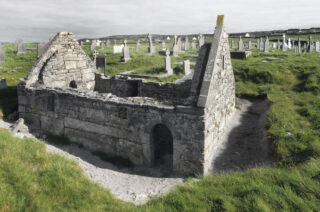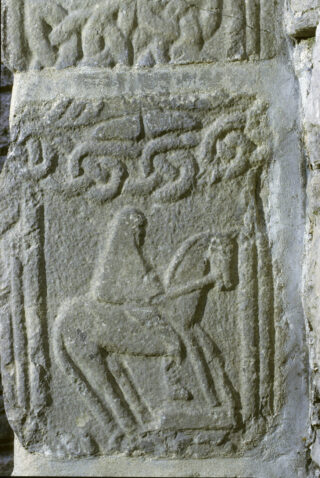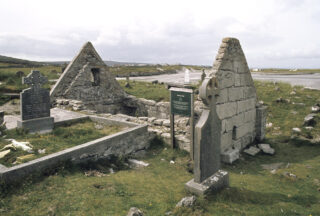Srianta
- Dromchla míchothrom
- Siúlóidí míchothrom
Séadchomhartha Náisiúnta is ea Teaghlach Éinne atá faoi úinéireacht an stáit agus faoi chúram Oifig na nOibreacha Poiblí
*Eolas Sábháilteachta: Tá an talamh i Reilig Chill Éinne thar a bheith míchothrom agus tá dumhcha thart ar an séipéal. Caithfear a bheith cúramach.*
WARNING: It should be noted that these sites are unguided and a level of care and caution should be maintained during all stages of your visit. The Office Of Public Works (OPW) will not be held responsible for any damages, injuries, or losses that occur
Séipéal beag meánaoise é Teaghlach Éinne atá suite i Reilig Chill Éinne. Tá sé leathshlogtha i ndumhcha. Bhíodh an séipéal seo mar chuid de mhainistir thábhachtach luath-mheánaoiseach, Cill Éinne, a bhfuil an ceantar seo den oileán ainmnithe ina diaidh. Deirtear gurbh é Naomh Éanna, éarlamh an oileáin, a bhunaigh í sa 6ú céad. Bhunaigh deisceabail Éanna séipéil thábhachtacha eile, fearacht Chluain Mhic Nóis agus Chluain Ioraird.
Scríobh an scoláire Gaelach, Ruairí Ó Flaitheartaigh, sa bhliain 1684, go bhfuil ar a laghad 120 naomh curtha sa reilig, Éanna féin ina measc. Shílfí go bhfuil bloic chloiche millteanach mór i gceist le ballaí an tséipéil, ach is leaca caola cloiche, atá líonta le spallaí, atá i gceist leo. Tá ‘antae starracha’ suaithinseacha ar an mballa binne thoir, rud a thugann le fios gur dócha gurb é sin an chuid is sine den fhoirgneamh atá fós ann — ón 9ú céad b’fhéidir. Bheadh díon adhmaid ina luí ar na antae, agus b’fhéidir gur chuaillí cúinne séipéil adhmaid ní ba luaithe iad. Tá inscríbhinn chliathánach ar éadan seachtrach an bhalla thuaidh, díreach faoin bhfuinneog: ORAIT AR SCANDLAN: ‘guigh ar son Scandlan’. B’fhéidir go raibh Scandlan i measc na ndaoine a tháinig i ndiaidh Éanna mar ab na mainistreach.
Taobh istigh den séipéal, tá trí phíosa d’ardchros ón 11ú céad stroighnithe le chéile. Bhíodh sí ina seasamh gar do bhun an chloigthí. Tá marcach ar a bhfuil cochall ar cheann amháin acu. B’fhéidir gur léiriú ar Íosa agus é ag dul isteach in Iarúsailéim é sin. Tá clocha crosghreanta agus giotaí saoirseachta ó thráthanna éagsúla stroighnithe le chéile chun altóir bheag a chruthú.
Gabh chuig Amharcóir Timpeallachta Stairiúla le tuilleadh eolais a fháil faoi Theaghlach Éinne
Cosaint dár Stair – Cliceáil anseo chun léamh faoin tábhacht atá leis na láithreán oidhreachta speisialta inár dtír a chosaint
Tá an séadchomhartha náisiúnta seo faoi chosaint de réir Achtanna na Séadchomharthaí Náisiúnta 1930 go 2014



Ceann de na dúnta is suntasaí in iarthar na hEorpa
Timpeall 8.1 km ón Teaghlach Éinne
Teachín ar maos sa stair réabhlóideach agus i gcultúr na nGael
Timpeall 32.0 km ón Teaghlach Éinne
Seoid stairiúil i gcroílár Chonamara
Timpeall 43.3 km ón Teaghlach Éinne
Féach le haoibhneas ar shnoiteáin fhíoráille na hAthbheochana
Timpeall 53.1 km ón Teaghlach Éinne
Faigh amach faoi Stair, Miotas agus Finscéal Inis Cathaigh
Timpeall 55.1 km ón Teaghlach Éinne
Suaitheantas de thiarnas na Normannach
Timpeall 64.4 km ón Teaghlach Éinne